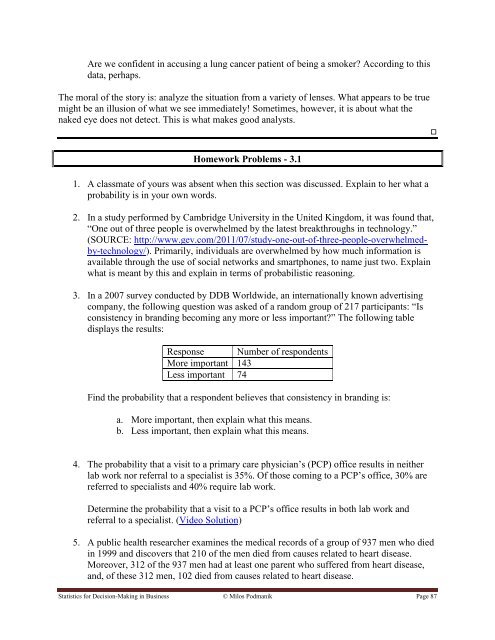Statistics for Decision- Making in Business - Maricopa Community ...
Statistics for Decision- Making in Business - Maricopa Community ...
Statistics for Decision- Making in Business - Maricopa Community ...
You also want an ePaper? Increase the reach of your titles
YUMPU automatically turns print PDFs into web optimized ePapers that Google loves.
Are we confident <strong>in</strong> accus<strong>in</strong>g a lung cancer patient of be<strong>in</strong>g a smoker Accord<strong>in</strong>g to this<br />
data, perhaps.<br />
The moral of the story is: analyze the situation from a variety of lenses. What appears to be true<br />
might be an illusion of what we see immediately! Sometimes, however, it is about what the<br />
naked eye does not detect. This is what makes good analysts.<br />
Homework Problems - 3.1<br />
1. A classmate of yours was absent when this section was discussed. Expla<strong>in</strong> to her what a<br />
probability is <strong>in</strong> your own words.<br />
2. In a study per<strong>for</strong>med by Cambridge University <strong>in</strong> the United K<strong>in</strong>gdom, it was found that,<br />
“One out of three people is overwhelmed by the latest breakthroughs <strong>in</strong> technology.”<br />
(SOURCE: http://www.gev.com/2011/07/study-one-out-of-three-people-overwhelmedby-technology/).<br />
Primarily, <strong>in</strong>dividuals are overwhelmed by how much <strong>in</strong><strong>for</strong>mation is<br />
available through the use of social networks and smartphones, to name just two. Expla<strong>in</strong><br />
what is meant by this and expla<strong>in</strong> <strong>in</strong> terms of probabilistic reason<strong>in</strong>g.<br />
3. In a 2007 survey conducted by DDB Worldwide, an <strong>in</strong>ternationally known advertis<strong>in</strong>g<br />
company, the follow<strong>in</strong>g question was asked of a random group of 217 participants: “Is<br />
consistency <strong>in</strong> brand<strong>in</strong>g becom<strong>in</strong>g any more or less important” The follow<strong>in</strong>g table<br />
displays the results:<br />
Response Number of respondents<br />
More important 143<br />
Less important 74<br />
F<strong>in</strong>d the probability that a respondent believes that consistency <strong>in</strong> brand<strong>in</strong>g is:<br />
a. More important, then expla<strong>in</strong> what this means.<br />
b. Less important, then expla<strong>in</strong> what this means.<br />
4. The probability that a visit to a primary care physician‟s (PCP) office results <strong>in</strong> neither<br />
lab work nor referral to a specialist is 35%. Of those com<strong>in</strong>g to a PCP‟s office, 30% are<br />
referred to specialists and 40% require lab work.<br />
Determ<strong>in</strong>e the probability that a visit to a PCP‟s office results <strong>in</strong> both lab work and<br />
referral to a specialist. (Video Solution)<br />
5. A public health researcher exam<strong>in</strong>es the medical records of a group of 937 men who died<br />
<strong>in</strong> 1999 and discovers that 210 of the men died from causes related to heart disease.<br />
Moreover, 312 of the 937 men had at least one parent who suffered from heart disease,<br />
and, of these 312 men, 102 died from causes related to heart disease.<br />
<strong>Statistics</strong> <strong>for</strong> <strong>Decision</strong>-<strong>Mak<strong>in</strong>g</strong> <strong>in</strong> Bus<strong>in</strong>ess © Milos Podmanik Page 87
















